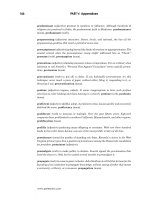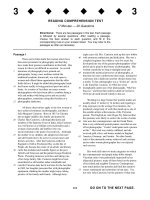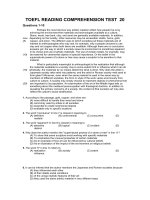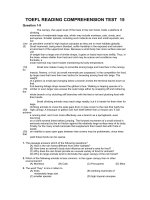TOEFL READING COMPREHENSION TEST 26
Bạn đang xem bản rút gọn của tài liệu. Xem và tải ngay bản đầy đủ của tài liệu tại đây (81.82 KB, 7 trang )
TOEFL READING COMPREHENSION TEST 26
Questions 1-9
The geology of the Earth's surface is dominated by the particular properties of
water. Present on Earth in solid, liquid, and gaseous states, water is exceptionally
reactive. It dissolves, transports, and precipitates many chemical compounds and is
Line constantly modifying the face of the Earth.
(5) Evaporated from the oceans, water vapor forms clouds, some of which are
transported by wind over the continents. Condensation from the clouds provides the
essential agent of continental erosion: rain. Precipitated onto the ground, the water
trickles down to form brooks, streams, and rivers, constituting what is called the
hydrographic network. This immense polarized network channels the water toward a
(10) single receptacle: an ocean. Gravity dominates this entire step in the cycle because
water tends to minimize its potential energy by running from high altitudes toward the
reference point that is sea level.
The rate at which a molecule of water passes though the cycle is not random but
is
a measure of the relative size of the various reservoirs. If we define residence time as
(15) the average time for a water molecule to pass through one of the three
reservoirsatmosphere,
continent, and ocean-we see that the times are very different. A water
molecule stays, on average, eleven days in the atmosphere, one hundred years on a
continent and forty thousand years in the ocean. This last figure shows the importance
of the ocean as the principal reservoir of the hydrosphere but also the rapidity of water
(20) transport on the continents.
A vast chemical separation process takes places during the flow of water over
the
continents. Soluble ions such as calcium, sodium, potassium, and some magnesium
are
dissolved and transported. Insoluble ions such as aluminum, iron, and silicon stay
where they are and form the thin, fertile skin of soil on which vegetation can grow.
(25) Sometimes soils are destroyed and transported mechanically during flooding. The
erosion of the continents thus results from two closely linked and interdependent
processes, chemical erosion and mechanical erosion. Their respective interactions and
efficiency depend on different factors.
1. The word "modifying" in line 4 is closest in meaning to
(A) changing (B) traveling (C) describing (D)
destroying
2. The word "which" in line 5 refers to
(A) clouds (B) oceans (C) continents (D)
compounds
3. According to the passage, clouds are primarily formed by water
(A) precipitating onto the ground (B) changing from a solid to a liquid
state
(C) evaporating from the oceans (D) being carried by wind
4. The passage suggests that the purpose of the "hydrographic network" (line 9) is to
(A) determine the size of molecules of water
(B) prevent soil erosion caused by flooding
(C) move water from the Earth's surface to the oceans
(D) regulate the rate of water flow from streams and rivers
5. What determines the rate at which a molecule of water moves through the cycle, as
discussed in the third paragraph?
(A) The potential energy contained in water
(B) The effects of atmospheric pressure on chemical compounds
(C) The amounts of rainfall that fall on the continents
(D) The relative size of the water storage areas
6. The word "rapidity" in line 19 is closest in meaning to
(A) significance (B) method (C) swiftness (D)
reliability
7. The word "they" in line 24 refers to
(A) insoluble ions (B) soluble ions (C) soils (D)
continents
8. All of the following are example of soluble ions EXCEPT
(A) magnesium (B) iron (C) potassium (D)
calcium
9. The word "efficiency" in line 28 is closest in meaning to
(A) relationship (B) growth (C) influence (D)
effectiveness
Questions 10-19
Among the species of seabirds that use the windswept cliffs of the Atlantic coast
of
Canada in the summer to mate, lay eggs, and rear their young are common murres,
Atlantic puffins, black-legged kittiwakes, and northern gannets. Of all the birds on
Line these cliffs, the black-legged kittiwake gull is the best suited for nesting on narrow
(5) ledges. Although its nesting habits are similar to those of gulls that nest on flat ground,
there are a number of important differences related to the cliff-nesting habit.
The advantage of nesting on cliffs is the immunity it gives from foxes, which
cannot scale the sheer rocks, and from ravens and other species of gulls, which have
difficulty in landing on narrow ledges to steal eggs. This immunity has been followed
(10) by a relaxation of the defenses, and kittiwakes do not react to predators nearly as
fiercely as do ground-nesting gulls. A colony of Bonaparte's gulls responds to the
appearance of a predatory herring gull by flying up as a group with a clamor of alarm
calls, followed by concerted mobbing, but kittiwakes dimply ignore herring gulls, since
they pose little threat to nests on cliffs. Neither do kittiwakes attempt to conceal their
(15) nest. Most gulls keep the nest area clear of droppings, and remove empty eggshells
after the chicks have hatched, so that the location of the nest is not given away.
Kittiwakes defeacate over the edge of the nest, which keeps it clean, but this practice,
as
well as their tendency to leave the nest littered with eggshells, makes its location very
conspicuous.
(20) On the other hand, nesting on a narrow ledge has its own peculiar problems, and
kittiwake behavior has become adapted to overcome them. The female kittiwake sits
when mating, whereas other gulls stand, so the pair will not overbalance and fall off the
ledge. The nest is a deep cup, made of mud or seaweed, to hold the eggs safely,
compared with the shallow scrape of other gulls, and the chicks are remarkably
(25) immobile until fully grown. They do not run from their nests when approached, and if
they should come near to the cliff edge, they instinctively turn back.
10. What aspect of the kittiwake gull does the passage mainly discuss?
(A) Its defensive behavior
(B) It interactions with other gull species
(C) Its nesting habits
(D) Its physical difference from other gull species
11. The word "rear" in line 2 is closest in meaning to
(A) visit (B) watch (C) reverse (D) raise
12. The word "scale" in line 8 is closest in meaning to
(A) climb (B) avoid (C) approach (D)
measure
13. The word "immunity" in line 9 is closest in meaning to
(A) distance (B) transition (C) protection (D)
reminder
14. Why is it difficult for ravens to steal the kittiwakes' eggs?
(A) The kittiwakes can see the ravens approaching the nest.
(B) The ravens cannot land on the narrow ledges where kittiwakes nest.
(C) The kittiwakes' eggs are too big for the ravens to carry.
(D) The female kittiwakes rarely leave the nest.
15. The author mentions that eggshells little the nests of kittiwakes in order to
(A) demonstrate that kittiwakes are not concerned about predators
(B) prove how busy kittiwakes are in caring for their offspring
(C) show a similarity to other types of gulls
(D) illustrate kittiwakes' lack of concern for their chicks
16. According to the passage, it can be inferred that which of the following birds conceal their
nest?
(A) Bonaparte's gulls (B) Atlantic puffins
(C) Kittiwake gulls (D) Northern gannets
17. The word "it" in line 17 refers to
(A) location (B) edge (C) nest (D)
practice
18. The word "conspicuous" in line 19 is closest in meaning to
(A) disordered (B) suspicious (C) noticeable (D)
appealing
19. The phrase "On the other hand" in line 20 is closest in meaning to
(A) therefore (B) however (C) for example (D) by no
means
Questions 20-29
Throughout the nineteenth century and into the twentieth, citizens of the United
States maintained a bias against big cities. Most lived on farms and in small towns and
believed cities to be centers of corruption, crime, poverty, and moral degradation. Their
Line distrust was caused, in part, by a national ideology that proclaimed farming the
greatest
(5) occupation and rural living superior to urban living. This attitude prevailed even as the
number of urban dwellers increased and cities became an essential feature of the
national landscape. Gradually, economic reality overcame ideology. Thousands
abandoned the precarious life on the farm for more secure and better paying jobs in the
city. But when these people migrated from the countryside, they carried their fears and
(10) suspicious with them. These new urbanities, already convinced that cities were
overwhelmed with great problems, eagerly embraced the progressive reforms that
promised to bring order out of the chaos of the city.
One of many reforms came in the area of public utilities. Water and sewerage
systems were usually operated by municipal governments, but the gas and electric
(15) networks were privately owned. Reformers fared that the privately owned utility
companies would charge exorbitant rates for these essential services and deliver them
only to people who could afford them. Some city and state governments responded by
regulating the utility companies, but a number of cities began to supply these services
themselves. Proponents of these reforms argued that public ownership and regulation
(20) would insure widespread access to these utilities and guarantee a fair price.
While some reforms focused on government and public behavior, others looked
at
the cities as a whole. Civic leaders, convinced that physical environment influenced
human behavior, argued that cities should develop master plans to guide their future
growth and development. City planning was nothing new, but the rapid industrialization
(25) and urban growth of the late nineteenth century took place without any consideration
for order. Urban renewal in the twentieth century followed several courses. Some cities
introduced plans to completely rebuild the city core. Most other cities contented
themselves with zoning plans for regulating future growth. Certain parts of town were
restricted to residential use, while others were set aside for industrial or commercial
(30) development.
20. What does the passage mainly discuss?
(A) A comparison of urban and rural life in the early twentieth century
(B) The role of government in twentieth-century urban renewal
(C) Efforts to improve urban life in the early twentieth century
(D) Methods of controlling urban growth in the twentieth century
21. The word "bias" in line 2 is closest in meaning to
(A) diagonal (B) slope (C) distortion (D)
prejudice
22. The first paragraph suggests that most people who lived in rural areas
(A) were suspicious of their neighbors
(B) were very proud of their lifestyle
(C) believed city government had too much power
(D) wanted to move to the cities
23. In the early twentieth century, many rural dwellers migrated to the city in order to
(A) participate in the urban reform movement
(B) seek financial security
(C) comply with a government ordinance
(D) avoid crime and corruption
24. The word "embraced" in line 11 is closest in meaning to
(A) suggested (B) overestimated (C) demanded (D)
welcomed
25. What concern did reformers have about privately owned utility companies?
(A) They feared the services would not be made available to all city dwellers.
(B) They believed private ownership would slow economic growth
(C) They did not trust the companies to obey the government regulations.
(D) They wanted to ensure that the services would be provided to rural areas.
26. The word "exorbitant" in line 16 is closest in meaning to
(A) additional (B) expensive (C) various (D)
modified
27. All of the following were the direct result of public utility reforms EXCEPT
(A) local governments determined the rates charged by private utility companies
(B) some utility companies were owned and operated by local governments
(C) the availability of services was regulated by local government
(D) private utility companies were required to pay a fee to local governments
28. The word "Proponents" in line 19 is closest in meaning to
(A) Experts (B) Pioneers (C) Reviewers (D)
Supporters
29. Why does the author mention "industrialization" (line 24)?
(A) To explain how fast urban growth led to poorly designed cities
(B) To emphasize the economic importance of urban areas
(C) To suggest that labor disputes had become an urban problem
(D) To illustrate the need for construction of new factories
Questions 30-39
By 1776 the fine art of painting as it had developed in western Europe up to this
time had been introduced into the American colonies though books and prints,
European visitors and immigrants, and traveling colonists who brought back copies
Line (and a few original) of old master paintings and acquaintance with European art
(5) institutions.
By the outbreak of the Revolution against British rule in 1776, the status of the
artists had already undergone change. In the mid-eighteenth century, painters had
been
willing to assume such artisan-related tasks as varnishing, gilding teaching, keeping
shops, and painting wheel carriages, houses, and signs. The terminology by which
(10) artists were described at the time suggests their status: "limner" was usually applied to
the anonymous portrait painter up to the 1760's: "painter" characterized anyone who
could paint a flat surface. By the second half of the century, colonial artists who were
trained in England or educated in the classics rejected the status of laborer and thought
of themselves as artists. Some colonial urban portraitists, such as John Singleton
Copley,
(15) Benjamin West, and Charles Wilson Peale, consorted with affluent patrons. Although
subject to fluctuations in their economic status, all three enjoyed sufficient patronage to
allow them to maintain an image of themselves as professional artists, an image
indicated by their custom of signing their paintings. A few art collectors James
Bowdoin III of Boston, William Byrd of Virginian, and the Aliens and Hamiltons of
(20) Philadelphia introduced European art traditions to those colonists privileged to visit
their galleries, especially aspiring artists, and established in their respective
communities the idea of the value of art and the need for institutions devoted to its
encouragement.
Although the colonists tended to favor portraits, they also accepted landscapes,
(25) historical works, and political engravings as appropriate artistic subjects. With the
coming of independence from the British Crown, a sufficient number of artists and their
works were available to serve nationalistic purposes. The achievements of the colonial
artists, particularly those of Copley, West, and Peale, lent credence to the boast that
the
new nation was capable of encouraging genius and that political liberty was congenial
(30) to the development of taste-a necessary step before art could assume an important
role
in the new republic.
30. What does the passage mainly discuss?
(A) European influence on colonial American painting
(B) The importance of patronage to artist
(C) The changing status of artists in the American colonies in the eighteenth century
(D) Subjects preferred by artists in the American colonies in the eighteenth century.
31. The word "outbreak" in line 6 is closest in meaning to
(A) cause (B) beginning (C) position (D)
explanation
32. The word "undergone" in line 7 is closest in meaning to
(A) led to (B) transformed (C) preferred (D)
experienced
33. According to the passage, before the American Revolution the main task of limners was to
(A) paint wheel carriages (B) paint portraits
(C) varnish furniture (D) paint flat surfaces
34. It can be inferred from the passage that artists who were trained in England
(A) considered artists to be superior to painters
(B) barely painted portraitists
(C) were often very wealthy
(D) imitated English painters
35. The word "consorted" in line 15 is closest in meaning to
(A) made decisions (B) studies (C) agreed (D)
associated
36. The word "sufficient" in line 16 is closest in meaning to
(A) adequate (B) temporary (C) friendly (D)
expensive
37. According to the passage, artists such as Copley, West and Peal signed their paintings
because it
(A) increased the monetary value of the paintings
(B) made it more difficult for other artists to copy the paintings
(C) supported the artists' image of professionalism
(D) distinguished colonial American artists from European artists
38. The author mentions James Bowdoin III and William Byrd in line 19 as examples of which
of the following?
(A) Art gallery owners who displayed only European art
(B) Art collectors who had a profound influence on American attitudes toward art
(C) Artists who gave financial support to other artists
(D) Patrons whose helped to encourage artisans to become artists
39. With which of the following would the author be most likely to agree?
(A) Countries that have not had a political revolution are unlikely to develop great art.
(B) The most successful art collectors are usually artists themselves.
(C) The value of colonial American paintings decreased after the Revolution.
(D) Colonial artists made an important contribution to the evolving culture of the new
nation.
Questions 40-50
Railroads reshaped the North American environment and reoriented North
American behavior. "In a quarter of a century", claimed the Omaha Daily Republican in
1883, "they have made the people of the United States homogeneous, breaking
through
Line the peculiarities and provincialisms which marked separate and unmingling sections."
(5) The railroad simultaneously stripped the landscape of the natural resources,
made
velocity of transport and economy of scale necessary parts of industrial production, and
carried consumer goods to households; it dispatched immigrants to unsettled places,
drew emigrants away from farms and villages to cities, and sent men and guns to
battle.
It standardized time and travel, seeking to annihilate distance and space by allowing
(10) movement at any time and in any season or type of weather. In its grand and
impressive
terminals and stations, architects recreated historic Roman temples and public baths,
French chateaus and Italian bell towers-edifices that people used as stages for many of
everyday life's high emotions: meeting and parting, waiting and worrying, planning
new starts or coming home.
(15) Passenger terminals, like the luxury express trains that hurled people over spots,
spotlight the romance of railroading. (The twentieth-Century Limited sped between
Chicago and New York in twenty hours by 1915). Equally important to everyday life
were the slow freight trans chugging through industrial zones, the morning and
evening commuter locals shuttling back ions and urban terminals, and the incessant
(20) comings and goings that occurred in the classifications, or switching, yards. Moreover,
in addition to its being a transportation pathway equipped with a mammoth physical
plant of tracks signals, crossings, bridges, and junctions, plus telegraph and telephone
lines the railroad nurtured factory complexes, coat piles, warehouses, and generating
stations, forming along its right-of-way what has aptly been called "the metropolitan
(25) corridor" of the American landscape.
40. What does the passage mainly discuss?
(A) The influence of ancient architecture on the design of railroad terminals
(B) The importance of natural resources in the development of railroads
(C) The railroad's impact on daily life in the United States in the nineteenth century
(D) Technological improvements in the area of communication in the nineteenth century
41. It can be inferred from the quote from the Omaha Daily Republican (line 2-5) that railroads
(A) made all sections of the nation much wealthier
(B) brought more unity to what had been a fragmented nation
(C) reduced dependence on natural resources
(D) had no effect on the environment of the United States
42. The word "it" in line 7 refers to
(A) transport (B) scale (C) production (D)
railroad
43. The word "drew" in line 8 is closest
(A) obliged (B) designed (C) helped (D)
attracted
44. The word "annihilate" in line 9 is closest in meaning to
(A) conquer (B) utilize (C) separate (D)
mechanize
45. The word "Moreover" in line 20 is closest in meaning to
(A) consequently (B) furthermore (C) although (D)
because
46. All of the following were true of impressive passenger terminals EXCEPT:
(A) Their architecture was influenced by the architecture of Europe.
(B) Luxury express trains traveled between them.
(C) They were usually located in small towns.
(D) They were important to many commuters.
47. According to the passage, which type of development lined the area along the
metropolitan corridor?
(A) Stores and shopping areas (B) Recreational areas
(C) Industrial (D) Agricultural
48. The word "aptly" in line 24 is closest in meaning to
(A) appropriately (B) virtually (C) consistently (D)
incessantly
49. The author mentions the Twentieth-Century Limited as an example of
(A) a freight train (B) a commuter train
(C) a luxury train (D) an underground train
50. The author gives a synonym for which of the following words?
(A) Homogeneous (line 3) (B) Standardized (line 9)
(C) Temples (line 11) (D) Classification (line 20)









